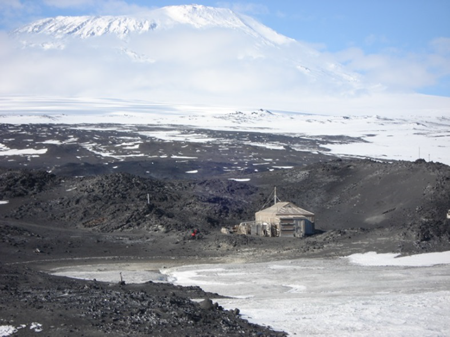
Ernest Shackleton’s Hut at Cape Royds is among the most famous historic sites on the Antarctic Continent. Recent years have seen Shackleton’s stature grow as the Antarctic explorer who led by example and “never lost a man,” largely at the expense of the reputation of Captain Scott who is often seen as having been somewhat aloof and distant from his men. The light, open-plan layout of the Cape Royd’s hut contrasts starkly with Captain Scott’s darker and more segregated hut at Cape Evans, and the design of the two huts might be seen as reflecting the respective leadership styles. The two huts have been subjects of recent restoration efforts by the New Zealand based Antarctic Heritage Trust (http://www.nzaht.org/), and they offer a wonderful insight into the lives of explorers during the heroic era of Antarctic exploration (roughly 1895-1917). The history of Antarctica’s heroic era can contribute to contemporary scientific research. In the Dry Valleys, our environmental history work is advancing our understanding of the recent past, before the ozone hole. As will be discussed in a Sunday evening science lecture, in much the same way that the relatively simple ecosystems of the McMurdo Dry Valleys offer a useful location for asking important ecological questions, the relative simplicity of Antarctic history offers a useful model for thinking about collaborations between historians and ecologists. During the Shackleton expedition’s stay at Cape Royds James Murray collected a significant number of diatom samples. Back in London, the diatoms were examined by the pioneering father and son team of W. West and G.S. West who identified thirty taxa from eight genera, eight of which were described as new species (West and West 1911). Since this was one of the first investigations of its type in the region, coupled with the very low species richness in Antarctica, this paper became highly influential for the next 100 years. As a result, Cape Royds is the type locality of roughly 1/6th of the continental flora, including several endemic Antarctic species which are common but always present at low relative abundance in DV streams. As more diatomists collected samples from the Antarctic, their identifications have been based on either a European flora, or the work of pioneers like West and West. With the modest descriptions and illustrations that West and West provided with limited technology, species have, for the last century, been force-fitted to the description of particular taxa, resulting in “species drift” with “concepts” for many species. Given the utility of diatoms in answering past and present ecological and biogeographical questions in the Antarctic, the need for advances in diatom taxonomy has become apparent. In a collaboration with our European colleagues, we are working towards a unified Antarctic flora. Our first step is to reinvestigate the diatoms from Cape Royds. Using the historical records of the Shackleton expedition we are identifying the various sites where Murray and his colleagues collected diatom samples. While some of the sample sites are fairly obvious, others take some historical research to identify. This resampling project will clarify important uncertainties in Antarctic diatom taxonomy, and will reveal which conditions favor these species. M.S. student Aneliya Skaeva will be looking for similar habitats in the MDV that might be sources for aeolian distribution of these diatoms to the streams and cryoconites.
Visit the McMurdo Dry Valleys LTER Environmetal History site for the full experience.
